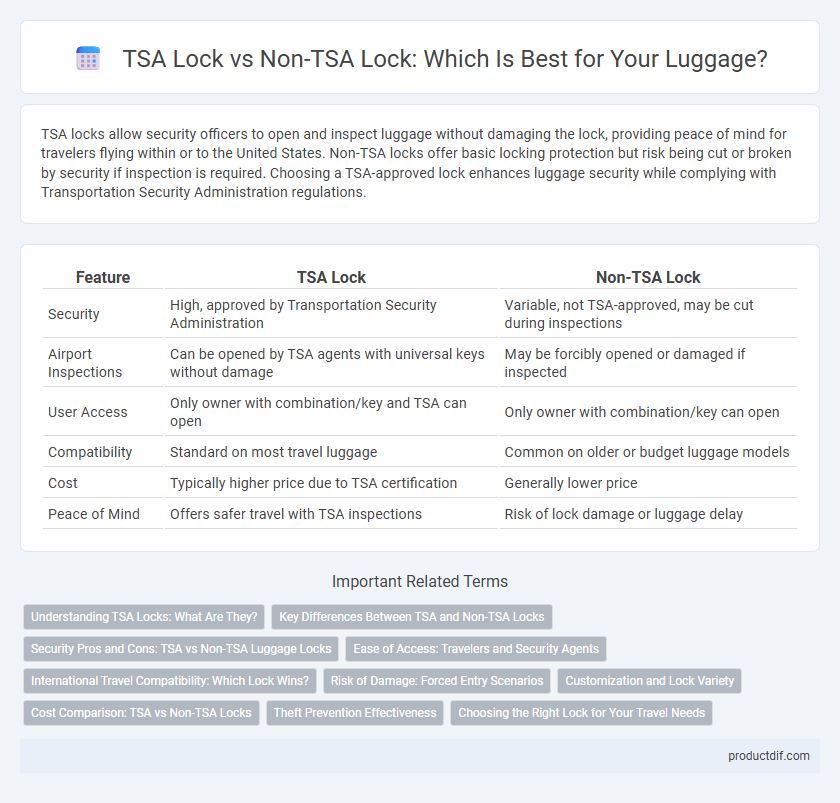TSA locks allow security officers to open and inspect luggage without damaging the lock, providing peace of mind for travelers flying within or to the United States. Non-TSA locks offer basic locking protection but risk being cut or broken by security if inspection is required. Choosing a TSA-approved lock enhances luggage security while complying with Transportation Security Administration regulations.
Table of Comparison
| Feature | TSA Lock | Non-TSA Lock |
|---|---|---|
| Security | High, approved by Transportation Security Administration | Variable, not TSA-approved, may be cut during inspections |
| Airport Inspections | Can be opened by TSA agents with universal keys without damage | May be forcibly opened or damaged if inspected |
| User Access | Only owner with combination/key and TSA can open | Only owner with combination/key can open |
| Compatibility | Standard on most travel luggage | Common on older or budget luggage models |
| Cost | Typically higher price due to TSA certification | Generally lower price |
| Peace of Mind | Offers safer travel with TSA inspections | Risk of lock damage or luggage delay |
Understanding TSA Locks: What Are They?
TSA locks are special travel locks approved by the Transportation Security Administration that allow security officers to open and inspect luggage without damaging the lock or the bag. These locks feature a universal key access system used exclusively by TSA agents, ensuring that travelers maintain security while complying with airport regulations. Non-TSA locks, while offering basic protection, may be cut or damaged during inspections since they cannot be opened by TSA personnel without a key.
Key Differences Between TSA and Non-TSA Locks
TSA locks are designed to allow Transportation Security Administration agents to unlock and inspect luggage using a master key without damaging the lock, making them essential for air travel in the United States. Non-TSA locks lack this feature and require travelers to either cut the lock or ask for assistance if TSA inspections are necessary, potentially causing damage to the luggage. Choosing between TSA and non-TSA locks depends on the travel destination, security preferences, and the frequency of air travel through TSA-monitored checkpoints.
Security Pros and Cons: TSA vs Non-TSA Luggage Locks
TSA locks provide enhanced security by allowing Transportation Security Administration agents to unlock and inspect luggage without damaging the lock, reducing the risk of forced entry during airport screening. Non-TSA locks may offer equally strong physical security but pose a potential risk of damage if inspection is required, as unauthorized cutting or breaking can occur. Choosing between TSA and non-TSA locks involves balancing convenience and inspection compliance against the potential vulnerability to forced entry.
Ease of Access: Travelers and Security Agents
TSA locks offer ease of access for both travelers and security agents by allowing authorized personnel to unlock and inspect luggage without damaging the lock, ensuring smooth airport security procedures. Non-TSA locks require travelers to unlock their bags themselves or risk lock breakage during security checks, which can lead to delays and potential damage. Choosing TSA-approved locks enhances convenience and security during travel, protecting belongings while complying with airport regulations.
International Travel Compatibility: Which Lock Wins?
TSA locks are specifically designed to allow Transportation Security Administration agents to open and inspect luggage without damaging the lock, making them essential for international travel to the United States where TSA inspections are common. Non-TSA locks cannot be opened by security officers without breaking, posing a risk of damage during routine customs inspections in many countries. For seamless international travel compatibility and enhanced security during inspections, TSA-approved locks are the superior choice.
Risk of Damage: Forced Entry Scenarios
TSA locks reduce the risk of damage during forced entry scenarios by allowing Transportation Security Administration agents to open luggage using universal master keys without breaking the lock. Non-TSA locks often result in damaged zippers, broken locks, or compromised luggage when security personnel forcibly open bags to inspect contents. Choosing TSA-approved locks minimizes costly repairs and preserves the integrity of the luggage under mandatory security checks.
Customization and Lock Variety
TSA locks offer enhanced customization with a wide range of combination settings, allowing travelers to set personalized codes for added security during airport screenings. Non-TSA locks provide fewer customization options but often come in diverse styles, such as padlocks and key locks, catering to individual preferences. Choosing between TSA and non-TSA locks depends on the need for official TSA access or preference for varied lock designs.
Cost Comparison: TSA vs Non-TSA Locks
TSA locks typically cost between $15 and $50, reflecting their advanced security features and compliance with Transportation Security Administration regulations. Non-TSA locks are generally less expensive, ranging from $5 to $20, but they lack TSA approval, which can lead to forced lock breakage during security inspections. Investing in TSA locks may increase upfront costs but offers potential savings by preventing damage and delays during air travel security checks.
Theft Prevention Effectiveness
TSA locks provide airport security with authorized access while maintaining theft prevention by minimizing damage during inspections, but they carry a risk if unauthorized individuals obtain master keys. Non-TSA locks offer stronger physical security by restricting any external access, yet they risk suitcase damage due to forced entry during security checks. Balancing theft prevention effectiveness depends on prioritizing secure access for inspections versus resisting unauthorized entry without compromise.
Choosing the Right Lock for Your Travel Needs
TSA locks are designed to provide enhanced security while allowing Transportation Security Administration agents to inspect luggage without causing damage, making them ideal for travelers frequently flying to or within the United States. Non-TSA locks may offer stronger resistance against tampering but risk being cut off during inspections, suitable for trips where TSA screening is less common. Selecting the right lock depends on your travel destinations, frequency of air travel, and preference for convenience versus maximum security.
TSA lock vs Non-TSA lock Infographic

 productdif.com
productdif.com